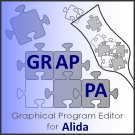Main Page
Alida - Advanced Library for Integrated Development of Data Analysis Applications
...formerly known as Alida - Automatic Logging of Process Information in Data Analysis
Alida defines a concept for designing libraries and toolkits in data analysis. It supports and simplifies integrated algorithm development by inherently joining algorithm implementation, automatic analysis process documentation and fully generic generation of user interfaces. In Alida each data analysis or manipulation action is realized in terms of an operator that acts on given data to produce desired output data. As all operators implement a common interface definition, their input and output parameters are accessible in a standardized manner, and they can also be invoked in a predefined way. Alida's concept is well-suited to ease algorithm development and their application to real-world problems by non-expert users. Due to the operator interface definition and the unified handling of operators it is for example possible to automatically generate user interfaces for operators, i.e. graphical frontends or commandline interfaces.
The Alida concept is independent of a specific programming language, however, relies on an object-oriented design. Moreover, in particular Java renders it quite easy to implement the conceptual features of Alida due to its reflection and annotation mechanisms. Anyway the concept has been implemented in two different programming languages.
Java implementation
The Java implementation of the Alida concept is in a quite mature state. It provides a framework for implementing and running operators. It also includes automatic process documentation and automatically generated command line and graphical user interfaces. Calls to operators not only produce data analysis results, but are at the same time registered within the framework together with all input and output objects as well as parameters settings of the various operators. These data acquired during an analysis process and the order of operator calls form a directed graph datastructure containing all relevant information for later reconstruction or verification of the analysis procedure. The Java implementation of Alida allows to make the directed graph datastructure explicit in terms of XML representations which can be visually explored with appropriate graphical frontends like Chipory, or might be stored in data bases for archival purposes.

- Grappa - the Graphical Programming Editor for Alida
Since release 2.0 Alida extends its operator concept towards combining operators into more complex workflows.
A workflow is defined as a combination of operators being excuted sequentially, in parallel or in a nested fashion.
The design of such workflows can best be done graphically, and Alida's core not only allows GUIs to be automatically generated,
but also significantly simplifies graphical programming. In particular, now the Java implementation of Alida includes Grappa, a graphical programming editor for designing workflows.
Grappa provides users with an intuitive tool for developing sophisticated image analysis workflows.
All Alida operators are right away available as operator nodes in Grappa and form the building blocks for workflows.
C++ implementation
The C++ implementation is mainly a proof-of-concept implementation. In its current state it is still lacking lots of features defined by the Alida concept, e.g. the automatic process documentation and automatically generated graphical user interfaces. Currently only the Java implementation is ready for use in practice.
News
- 01/17/2014:
Release of version 2.3.
The project management of the Alida Java project was switched to Maven, i.e. from now on Alida can be downloaded directly from our Maven server.
The new release by itself mainly includes bugfixes in the core of Alida improving the stability.
- 05/17/2013:
Alida will be presented at the MVA 2013, which is the Thirteenth IAPR International Conference on Machine Vision Applications.
The title of the contribution is A Framework Unifying the Development of Image Analysis Algorithms and Associated User Interfaces.
The conference will take place in Kyoto/Japan from May 21st to 23rd. We hope to meet you there!
- 05/17/2013:
Release of version 2.2.
Grappa has increased its user-friendliness by supporting key shortcuts now. In addition, the mechanism to save and load configurations in Alida
has switched from the Java serialization framework to XML beans. Finally, many bugfixes in Alida's core were again applied.
- 02/28/2013:
Release of version 2.1.
The new release includes many bugfixes in Alida's core improving the stability, and minor improvements regarding layout and handling of Alida's user interfaces.
Note that also a new version of the manual was released which now covers all important aspects of programming with Alida.
Licensing information
Alida is free software: you can redistribute it and/or modify under the terms of the GNU General Public License version 3 or (at your option) any later version as published by the Free Software Foundation.
Current releases
Java
You can download Alida's Java implementation in version 2.2 here.
You can find the API documentation for this release here.
C++
You can download Alida's prototypical C++ implementation in version 0.1 here.
You can find the API documentation for this release here.
Manual
Alida offers you a user and programmer manual you can download here.
Note that the manual is currently focussed on the mature Java implementation, but it will be updated in near future to cover both implementations.
Bug reports & Feature requests
Bug reports and feature requests can be submitted via the bugtracking system or by mail to alida@informatik.uni-halle.de.
Before reporting a new bug, please check if that bug has already been submitted in the report list.